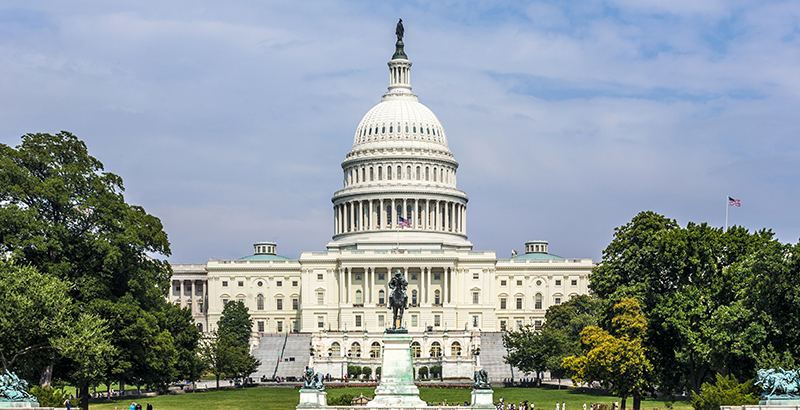As House Prepares to Approve Federal CTE Law, Some Worry That Senate Provision Could Incentivize States to Lower Their Goals for Students

Update, July 31: President Trump signed the Strengthening Career and Technical Education for the 21st Century Act Tuesday, making the legislation the first in his presidency to make major changes to federal education law.
During an appearance at Tampa Bay Technical High School in Florida, Trump put his signature to the bill that reauthorizes the Carl D. Perkins Career and Technical Education Act, allowing states to set their own goals for career and technical education.
In a statement, Trump said, “By enacting it into law, we will continue to prepare students for today’s constantly shifting job market, and we will help employers find the workers they need to compete.”
Update, July 25: The House passed the CTE reauthorization Wednesday morning, sending the bill to President Trump, who’s been pushing for the legislation, for his expected signature. Sen. Lamar Alexander, who chairs the Senate education committee, tweeted this afternoon that he “is hopeful the legislation will become law this year.”
House members, like those in the Senate, passed the bill on a voice vote, meaning no one came to the floor to register his or her individual disagreement. It marked a rare moment of bipartisan legislative accomplishment in an otherwise sharply divided Congress.
Rep. Virginia Foxx, chair of the House Education and the Workforce Committee, called the bill “a true difference-maker” that will help change “misguided perceptions” that career education is a less worthy or rigorous choice than traditional higher education.
Blink and you might’ve missed it: Amid all the partisan rancor over ESSA implementation, school discipline guidance, Title IX rules, and a host of other education issues in the past year and a half, Congress is set to pass a bipartisan education law.
The Senate late Monday passed a reauthorization of the Carl D. Perkins Act, which sets rules for federal grants for career and technical education at the secondary and post-secondary level for the next six years. The House approved its own version last year and is slated to approve the Senate’s changes as soon as Wednesday evening, advocates said. President Trump, who’s focused on elevating the importance of career and technical training, could sign the new law shortly thereafter.
“I’m glad we were able to push partisanship aside and work together to invest in students and workers by giving them the education, skills and training they need to get better jobs and higher wages,” Sen. Patty Murray, ranking Democrat on the HELP committee, said in a press release.
The bill had also been a top priority of presidential adviser Ivanka Trump; in a tweet Monday evening, the president’s daughter said she was “optimistic that the House will act before recess so this important bipartisan legislation can be signed into law.”
CTE programs, long a holding area for students funneled into what was considered a less-academic track, have morphed to meet the needs of modern industry. Business leaders, who back the bill, have complained of a skills gap between what they need workers to know and what potential employees can actually do. CTE programs now include everything from traditional auto mechanics to the much-vaunted P-tech programs that train students to work in STEM fields.
The House, which passed Perkins reauthorization by wide bipartisan margins in 2016 and 2017, is scheduled to be in session through midday Thursday before leaving for a five-week recess.
Most notably, the bill would let state agencies set performance targets for their CTE programs, rather than requiring them to work out targets with the Department of Education as they do under current law.
Though the bill notably walks back the federal Education Department’s role in the standards and prohibits the secretary from prescribing curriculum, the Senate’s bill would allow the secretary to reduce grant funding to states that fail to meet 90 percent of performance targets for two consecutive years. Performance targets must measure things like high school graduation rate and attainment of industry credentials.
Kim Green, executive director of Advance CTE, told reporters on a Tuesday morning call that some advocates want to ensure that the threat of lost funding doesn’t result in “an unintended consequence of discouraging states from setting ambitious targets.”
Lawmakers should use the law’s accompanying documents to clarify that they did not intend for states to set lower targets for CTE students, she said.
“We definitely do not want to go back in time where there’s different tracks for CTE versus non-CTE students,” she said, referring to the perception that pursuing career and technical education is a less rigorous academic path and appropriate only for students not bound for college.
Though both versions of the bill reduce federal oversight, the Senate’s version also includes more regulations on how states will develop their Perkins implementation plans, like allowing 60 days for public comment on the plan and including those comments in their final submission to the Education Department.
Another key difference is the level of authorized funding for the grants, although it’s the appropriations committees in both chambers that actually dole out the money for the grants each year. The House Appropriations Committee approved $1.3 billion in CTE funding for fiscal 2019, while the Senate Appropriations Committee OKed $1.2 billion.
Get stories like these delivered straight to your inbox. Sign up for The 74 Newsletter

;)
